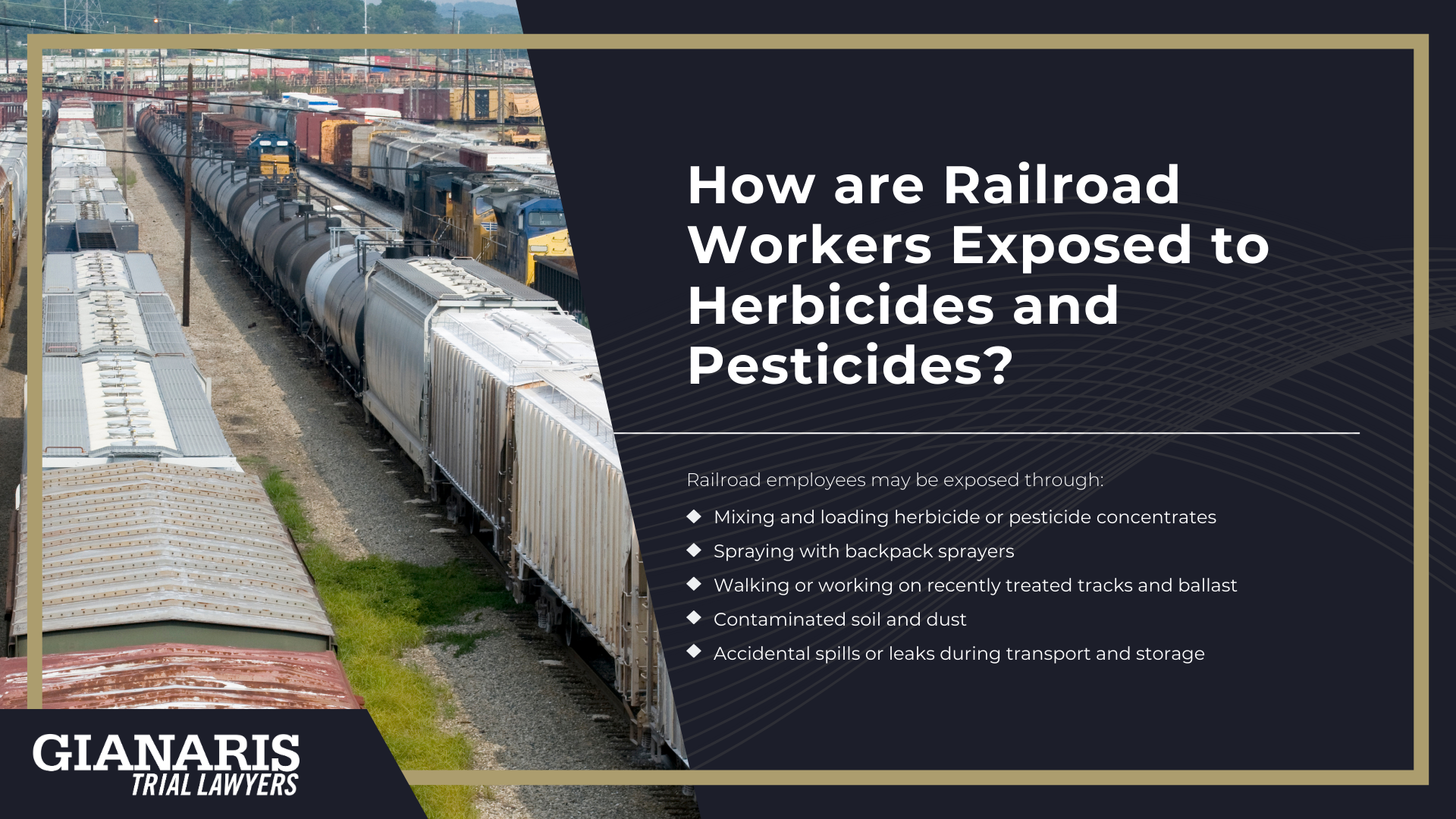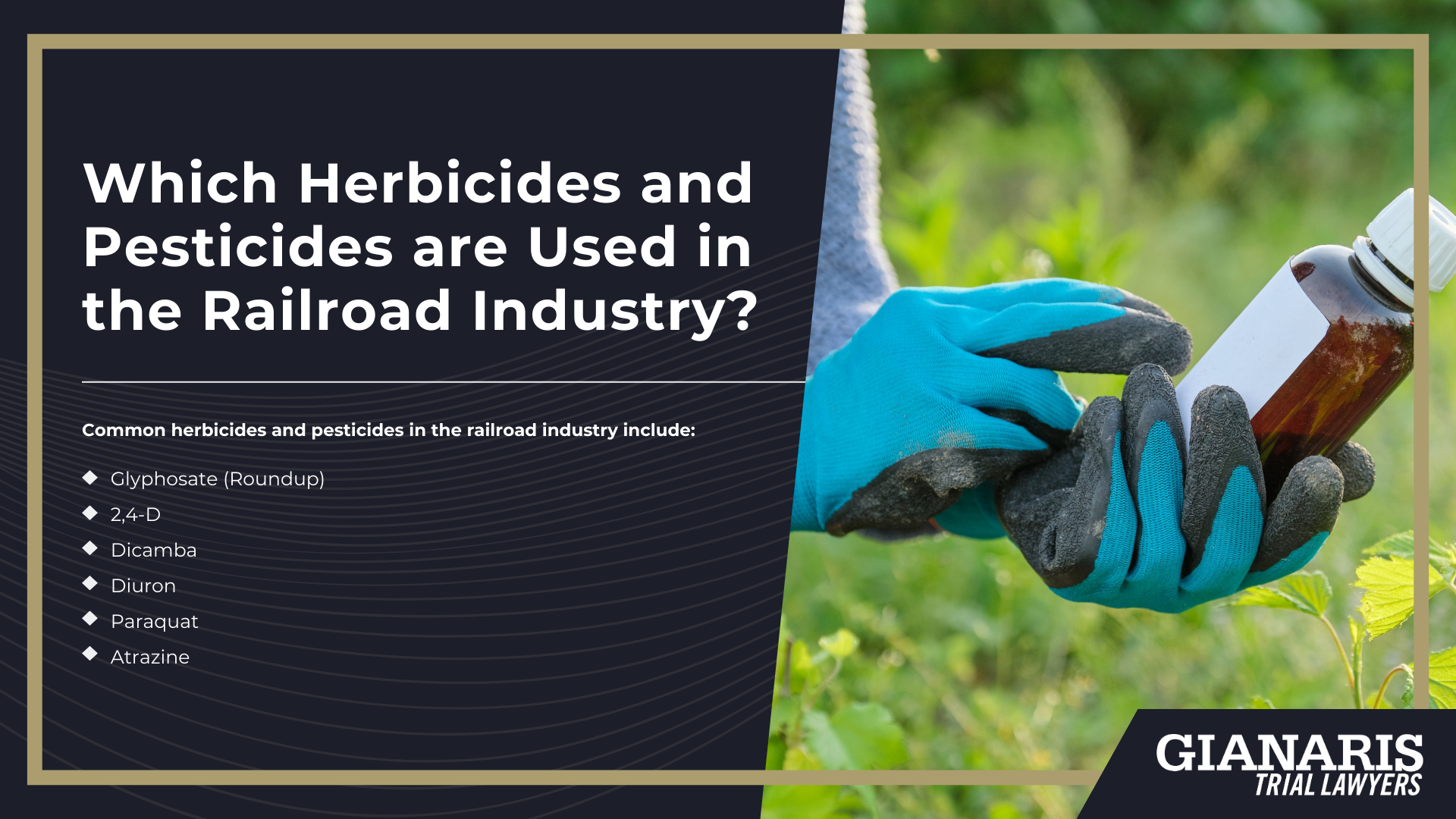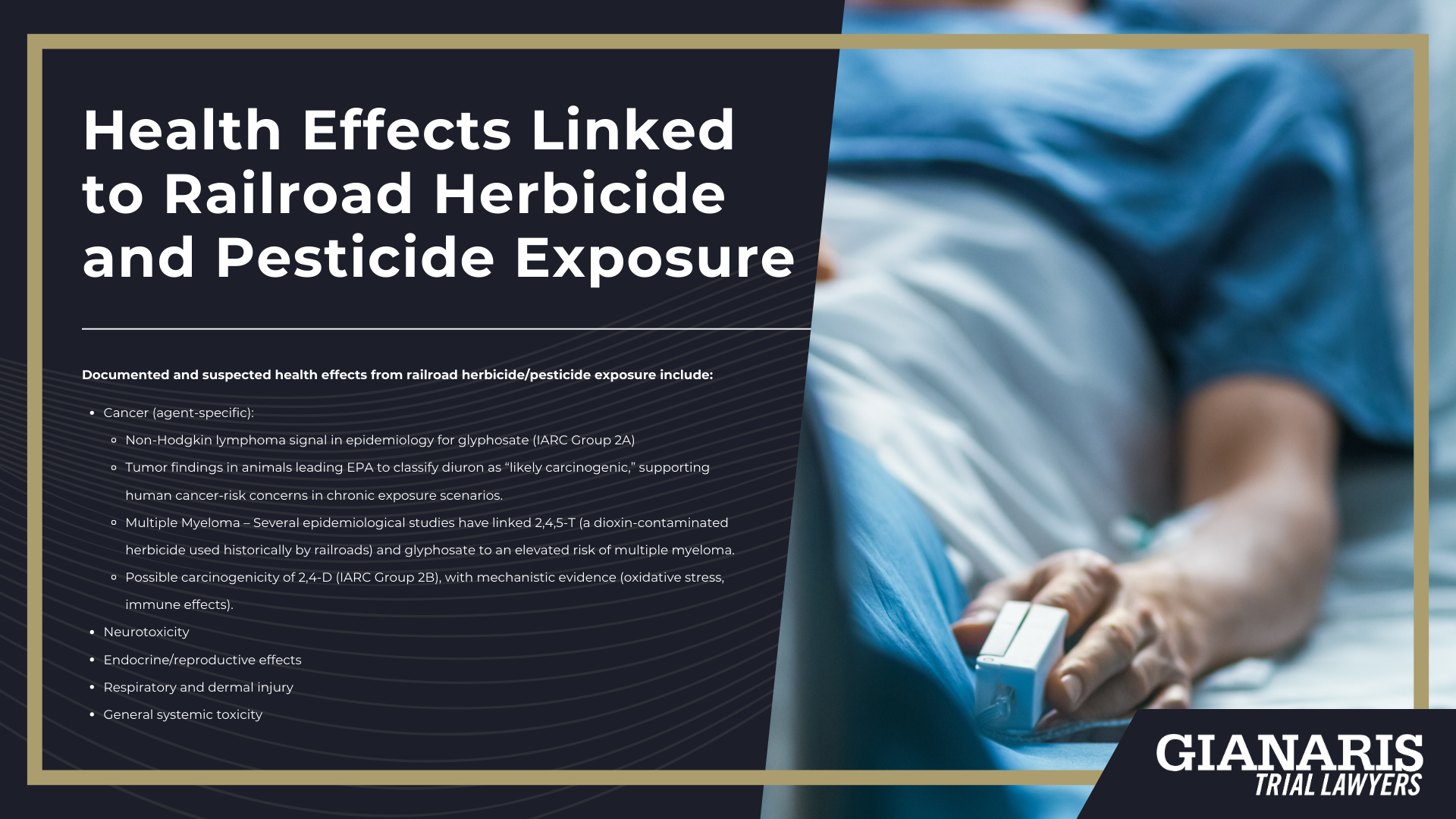Railroads rely on chemical herbicides and pesticides to control vegetation along tracks, switches, and rail yards.
These applications are necessary for safe operations, but they introduce toxic substances that railroad employees may encounter on a regular basis.
Studies confirm that workers face occupational exposure when they apply herbicides, mix chemical concentrates, or enter areas recently treated with weed control agents.
Common products include glyphosate, 2,4-D, dicamba, diuron, and paraquat, all of which have been linked to health risks in agricultural and industrial settings.
Exposure can occur both during application and through contact with treated soil, ballast, and equipment surfaces long after spraying.
Lack of protective equipment and training has further increased the risks for many workers, particularly those handling concentrated chemicals in confined spaces or with backpack sprayers.

Railroad employees may be exposed through:
- Mixing and loading herbicide or pesticide concentrates without proper ventilation or protective equipment.
- Spraying with backpack sprayers, hand sprayers, or mounted sprayers where drift and splash-back create inhalation and skin contact hazards.
- Walking or working on recently treated tracks and ballast, where residues can cling to clothing, boots, and skin.
- Contaminated soil and dust around rail yards and right-of-way corridors, which may retain dangerous chemicals for extended periods.
- Accidental spills or leaks during transport and storage of large herbicide and pesticide containers.
According to toxicological reviews, repeated or long-term exposure to these herbicides can result in chronic health problems, including cancer, neurological disorders, and respiratory issues.
The U.S. Environmental Protection Agency (EPA) has classified several of these chemicals as possible or probable human carcinogens, underscoring the risks faced by railroad employees who encounter them routinely.
With most railroads applying herbicides on a regular basis, the risk to workers and nearby communities remains a pressing occupational and environmental health concern.
Which Herbicides and Pesticides are Used in the Railroad Industry?
Railroads have long relied on chemical herbicides and pesticides to control vegetation along tracks, switches, and yards.
These products are chosen because they kill persistent weeds and invasive plants that threaten the stability of ballast and the safety of trains.
Many of the same chemicals used in agriculture have also been applied in rail operations, sometimes in large amounts and on a regular basis.
However, the history of these chemicals is closely tied to worker health concerns, litigation, and regulatory debate.
Railroad employees may have been exposed to some of the most controversial weed control agents in modern history.

Common herbicides and pesticides in the railroad industry include:
- Glyphosate (Roundup): Introduced in the 1970s, it became the most widely used herbicide worldwide; later linked in lawsuits to non-Hodgkin’s lymphoma and other health risks.
- 2,4-D: A synthetic herbicide first used in the 1940s; one of the components of Agent Orange, still widely used for railroad weed control.
- Dicamba: Developed in the 1960s and often used with other herbicides; known for drifting off-site and damaging nearby vegetation.
- Diuron: A long-lasting herbicide used to control weeds along rights-of-way; persistent in soil and water with potential ecological and health impacts.
- Paraquat: A highly toxic herbicide in use since the 1960s; associated with Parkinson’s disease and banned or restricted in many countries, but still applied in industrial vegetation control.
- Atrazine: One of the most common herbicides in the U.S. since the 1950s; linked to endocrine disruption and water contamination.
Health Effects Linked to Railroad Herbicide and Pesticide Exposure
Railroad vegetation control uses industrial herbicides that carry documented human-health hazards—especially for workers who mix, load, spray, or re-enter treated rights-of-way.
The International Agency for Research on Cancer (IARC) classifies glyphosate as “probably carcinogenic to humans” (Group 2A), citing a positive association with non-Hodgkin lymphoma.
The EPA’s Cancer Assessment Review Committee classifies diuron as “Likely to be Carcinogenic to Humans,” and IARC classifies 2,4-D as “possibly carcinogenic” (Group 2B) with evidence of oxidative stress and immunologic effects, both relevant to long-term railroad exposures.
For paraquat, federal and NIH/ATSDR-aligned literature links occupational exposure to increased Parkinson’s disease risk; EPA’s registration review has imposed additional mitigation due to toxicity.
Some herbicides also pose endocrine or developmental concerns ,such as atrazine used in some ROW programs, has been evaluated by EPA for endocrine-disrupting potential.

Documented and suspected health effects from railroad herbicide/pesticide exposure include:
- Cancer (agent-specific):
- Non-Hodgkin lymphoma signal in epidemiology for glyphosate (IARC Group 2A)
- Tumor findings in animals leading EPA to classify diuron as “likely carcinogenic,” supporting human cancer-risk concerns in chronic exposure scenarios.
- Multiple Myeloma – Several epidemiological studies have linked 2,4,5-T (a dioxin-contaminated herbicide used historically by railroads) and glyphosate to an elevated risk of multiple myeloma.
- Possible carcinogenicity of 2,4-D (IARC Group 2B), with mechanistic evidence (oxidative stress, immune effects).
- Neurotoxicity: Occupational paraquat exposure associated with Parkinson’s disease in meta-analyses and Agricultural Health Study evaluations; EPA has added risk-reduction measures in its review.
- Endocrine/reproductive effects: Atrazine evaluated by EPA as an endocrine-disrupting chemical with potential impacts depending on timing/dose—raising concerns for chronically exposed workers.
- Respiratory and dermal injury: Mixing/spraying can cause eye/skin irritation, chemical burns, and inhalation-related airway symptoms; risk is elevated during backpack/hand-wand applications and poor ventilation (consistent with pesticide label hazard statements and EPA risk discussions).
- General systemic toxicity: Depending on active ingredient and solvent, chronic exposure can contribute to liver/kidney effects and immune changes noted across pesticide risk assessments.
Taken together, authoritative agencies (IARC, EPA, NIH/ATSDR) recognize credible human-health hazards for several core railroad herbicides (especially with repeated occupational contact) supporting the need for controls, exposure documentation, and medical follow-up in potential litigation.
What Job Roles in the Railroad Industry are at Risk for Herbicide Exposure?
Railroads commonly rely on herbicide spraying for vegetation management to keep tracks clear, prevent fires, and maintain visibility for safe train operations.
Because most railroads apply these chemicals on a regular basis, a variety of workers may face exposure risks, especially when spraying occurs in the spring and summer months when weeds grow aggressively.
Crews tasked with applying herbicides directly face the greatest dangers, but other workers who spend long hours along the right-of-way can also come into contact with residues left on soil, ballast, and equipment.
The need to kill weeds quickly often leads to large-scale spraying operations without the benefit of full protective measures.
If chemicals are not handled correctly (or if weeds become resistant and require heavier treatments) railroad employees may be put at increased risk.
Even workers not directly mixing or spraying herbicides can face exposure when drifting spray settles on trains, yards, or nearby communities.

Job roles most at risk for herbicide exposure include:
- Track and vegetation crews – Workers who apply herbicides and perform proper maintenance of the right-of-way, often using truck-mounted sprayers or backpack sprayers.
- Maintenance-of-way employees – Individuals who inspect, repair, and maintain tracks, frequently working in areas where herbicides have been applied.
- Locomotive engineers and conductors – While not directly applying chemicals, they may determine when and where spraying occurs and operate trains over freshly treated areas, encountering residues.
- Yard workers and signal crews – Employees who maintain switches, signals, and other equipment in sprayed areas.
- Contract spraying teams – Third-party applicators hired by railroads to manage vegetation management programs, often handling large volumes of dangerous chemicals.
Because these exposures can be chronic and cumulative, understanding the specific dangers tied to each role is critical for both worker safety and for building strong legal claims when illnesses develop later in life.







